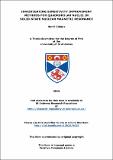Files in this item
Investigating sensitivity improvement methods for quadrupolar nuclei in solid-state nuclear magnetic resonance
Item metadata
| dc.contributor.advisor | Ashbrook, Sharon E. | |
| dc.contributor.author | Colaux, Henri | |
| dc.coverage.spatial | 488 p. | en_US |
| dc.date.accessioned | 2016-10-07T15:43:47Z | |
| dc.date.available | 2016-10-07T15:43:47Z | |
| dc.date.issued | 2016-11-30 | |
| dc.identifier.uri | https://hdl.handle.net/10023/9628 | |
| dc.description.abstract | The study of quadrupolar nuclei using NMR spectroscopy in the solid state significantly increased in popularity from the end of the 20th century, with the introduction of specific methods to acquire spectra free from the effects of the quadrupolar interaction, that results in broadened lineshapes that cannot be completely removed by spinning the sample at the magic angle (MAS), unlike most of the other interactions present in the solid state. The first technique which allows, without any specific hardware, the removal of this broadening has been the Multiple-Quantum MQMAS experiment. The method quickly gained a popularity within the NMR community, with numerous successful applications published. However, the multiple-quantum filtration step in this experiment relies on severely limits sensitivity, restricting application to the most sensitive nuclei. Extending the applicability of MQMAS to less receptive nuclei requires the use of signal improvement techniques. There are multiple examples of such approaches in the literature, but most of these require additional optimisation that may be time-consuming, or simply impossible, on less receptive nuclei. This work introduces a novel signal improvement technique for MQMAS, called FAM-N. Its optimisation is solely based on density matrix simulations using SIMPSON, implying no additional experimental optimisation is required, while improving the signal in MQMAS spectra by equivalent or higher amounts than other common methods. In order to prove the applicability of this method on virtually any system, FAM-N has been investigated by simulation, and tested experimentally using a number of model samples, as well as samples known to be challenging to study by NMR. This work also explores other aspects of NMR spectroscopy on quadrupolar nuclei. Adiabatic inversion of the satellite populations can be performed to improve the central transition signal in static or MAS spectra. A range of methods has been tested and compared, with particular attention given to hyperbolic secant-shaped pulses, for which its performance have been described. Finally, cross-polarisation from a spin I = 1/2 nucleus to a quadrupolar nucleus has been investigated. After reviewing the theory for the static case, simulations have been performed under MAS in order to identify the conditions for efficient magnetisation transfer, with applications in spectral editing or for the combination with MQMAS. | en_US |
| dc.language.iso | en | en_US |
| dc.publisher | University of St Andrews | |
| dc.rights | Attribution-NonCommercial-NoDerivatives 4.0 International | * |
| dc.rights.uri | http://creativecommons.org/licenses/by-nc-nd/4.0/ | * |
| dc.subject | Solid-state nuclear magnetic resonance | en_US |
| dc.subject | NMR | en_US |
| dc.subject | Multiple-quantum magic angle spinning | en_US |
| dc.subject | MQMAS | en_US |
| dc.subject | Fast-amplitude modulation | en_US |
| dc.subject | FAM | en_US |
| dc.subject | FAM-N | en_US |
| dc.subject | Double-frequency sweep | en_US |
| dc.subject | DFS | en_US |
| dc.subject | Hyperbolic secant | en_US |
| dc.subject | HS | en_US |
| dc.subject | Cross polarisation | en_US |
| dc.subject | CP | en_US |
| dc.subject.lcc | QD96.N8C7 | |
| dc.subject.lcsh | Nuclear magnetic resonance spectroscopy | en_US |
| dc.subject.lcsh | Nuclear spin | en_US |
| dc.subject.lcsh | Solid state chemistry | en_US |
| dc.title | Investigating sensitivity improvement methods for quadrupolar nuclei in solid-state nuclear magnetic resonance | en_US |
| dc.type | Thesis | en_US |
| dc.contributor.sponsor | Engineering and Physical Sciences Research Council (EPSRC) | en_US |
| dc.type.qualificationlevel | Doctoral | en_US |
| dc.type.qualificationname | PhD Doctor of Philosophy | en_US |
| dc.publisher.institution | The University of St Andrews | en_US |
The following licence files are associated with this item:
This item appears in the following Collection(s)
Except where otherwise noted within the work, this item's licence for re-use is described as Attribution-NonCommercial-NoDerivatives 4.0 International
Items in the St Andrews Research Repository are protected by copyright, with all rights reserved, unless otherwise indicated.


